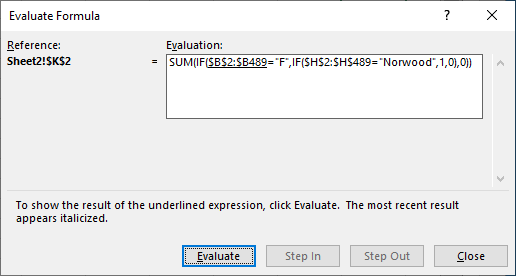Please Note: This article is written for users of the following Microsoft Excel versions: 2007, 2010, 2013, 2016, 2019, 2021, 2024, and Excel in Microsoft 365. If you are using an earlier version (Excel 2003 or earlier), this tip may not work for you. For a version of this tip written specifically for earlier versions of Excel, click here: Evaluating Formulas.
Written by Allen Wyatt (last updated March 29, 2025)
This tip applies to Excel 2007, 2010, 2013, 2016, 2019, 2021, 2024, and Excel in Microsoft 365
Often it is frustrating to figure out exactly how Excel arrives at a particular result—particularly if the formula returning the result is quite complex. Fortunately, Excel provides a tool you can use to help figure out what is going on when Excel evaluates a formula.
To use this tool, first select the cell that contains the formula you want evaluated. Then, display the Formulas tab of the ribbon. In the Formula Auditing group click the Evaluate Formula tool. Excel displays the Evaluate Formula dialog box. (See Figure 1.)

Figure 1. The Evaluate Formula dialog box.
At this point, Excel shows the full formula from the cell, and part of it is underlined. This underlined area represents the part of the formula that Excel will next evaluate. This allows you to see what intermediate steps Excel follows in arriving at a result. Every time you click the Evaluate button, Excel replaces the underlined portion of the formula with a result.
Nothing you do with the formula evaluator actually affects the formula in your worksheet; it remains unchanged. Instead, Excel simply shows you what happens as it works through each part of the formula to arrive at a result. When you are done using the formula evaluator, click the Close button.
It should be noted that the formula evaluator is for evaluating just what it says: formulas. It is not for evaluating other items, such as data points on charts or aggregated data in PivotTables.
ExcelTips is your source for cost-effective Microsoft Excel training. This tip (6236) applies to Microsoft Excel 2007, 2010, 2013, 2016, 2019, 2021, 2024, and Excel in Microsoft 365. You can find a version of this tip for the older menu interface of Excel here: Evaluating Formulas.

Professional Development Guidance! Four world-class developers offer start-to-finish guidance for building powerful, robust, and secure applications with Excel. The authors show how to consistently make the right design decisions and make the most of Excel's powerful features. Check out Professional Excel Development today!
Got some formulas you slaved over and want to use in lots of workbooks? This tip presents some helpful ideas on how you ...
Discover MoreIf you have a series of consecutive numbers in a column, you may want to know if it really is consecutive. (In other ...
Discover MoreIf you need to make everything in a cell lowercase except the first character, you may wonder if there is a formulaic way ...
Discover MoreFREE SERVICE: Get tips like this every week in ExcelTips, a free productivity newsletter. Enter your address and click "Subscribe."
2025-03-29 11:37:37
J. Woolley
You might also be interested in the Advanced Formula Environment provided by the Excel Labs add-in:
https://www.microsoft.com/en-us/garage/profiles/excel-labs/
Got a version of Excel that uses the ribbon interface (Excel 2007 or later)? This site is for you! If you use an earlier version of Excel, visit our ExcelTips site focusing on the menu interface.
FREE SERVICE: Get tips like this every week in ExcelTips, a free productivity newsletter. Enter your address and click "Subscribe."
Copyright © 2026 Sharon Parq Associates, Inc.
Comments